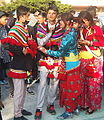Sunwar people

Kirati Sunuwar
|
|
| Total population | |
|---|---|
| (Approximately 100,000 (2012 est.)) | |
| Languages | |
| Sunwar, Nepali | |
| Religion | |
| Predominant Hinduism, Kiranti, Buddhism
|
The Sunwars or Sunuwars (Nepali: सुनुवार जाति) are one of the indigenous peoples of Nepal and some areas in India. The tribe is influenced by Hinduism. They speak the Sunwar language. According to the 2001 census, 79.50% of the Sunwars are Hindu, while 17.4% were Kirant.[1]
The Kiranti-Kõits are one of the Mongoloid tribes (anthropologically: Mongoloid stock) who number 96,254. The term ‘Kõits’ is also the name of the mother tongue. Other terms like Mukhiya or Mukhia are exonyms of the tribe. There is another common teasing name (mainly given by outsiders) of the tribe coined from the Sunwar language itself, e.g. Maaraapaache (lexically maar ‘what’ and patsaa ‘to do’, from when the speakers ask themselves maar patsaa? at the time trouble). Sunwars have their distinct language, religion, culture and social customs.
They inhabit the eastern hills of Nepal. They are autochthonous to the Molung Khola, Likhu Khola and Khimti Khola (‘Khola’ Indo-Aryan Nepali etymon ‘rivulet’). By administrative division, they dwell in Okhaldhunga, Ramechhap and Dolakha districts of Nepal, politically known as Wallo (‘Near/Hither’) Kirant (in the past and also in use among the Kirantis at present) after the fall of the Kirant dynasty (ruling for about 1903 years and 8 months) at the ancient Nepal valley. Wallo Kirant in the past was their Kipat or communal land. Their migration (mainly to the east) later took place in several parts of the country in Jhapa, Ilam, Panchthar, Taplejung, Terathum, Sunsari, Sindhuli, Kathmandu and other districts and abroad in Darjeeling, Sikkim, Dehradun, Bhutan, South Korea, Japan, UK USA, Canada,
Contents
Lifestyle
Most Sunuwars practice agriculture (approximately 55%) throughout the eastern hills of present-day Nepal. Crop cultivation and cattle farming (Rice, Millet, Wheat, Soybean, Potato, and Corn) are the main agricultural works. Sunuwar people also took part in the Second World War and they were known as brave and honest. Some Sunuwars still join the Nepal army, Nepal Police, Indian Army, Singapore Police Force and British Gurkha Army. Due to limited opportunities within the nation, people with education go abroad for work. Attractive salaries and facilities in other countries motivate these people for jobs abroad. Only few Sunuwar people are involved in the government service and private sectors in Nepal.
Traditional cultures
Sunuwar people are very rich in their traditional cultures. They have more than hundreds of traditional feast and festivals which is difficult to explain in details. Every traditional feasts and festivals have its own objectives, characteristics and system of celebration. Some greatest traditional festivals are mentioned. Chandi Puja in Baisakh Purnima, Sakela (Shyadar-Pidar), Gil puja (Gil-Pidar), Meserani puja (Meserani-Pidar) etc. are important. They celebrate Shyadar-pidar festival in the Day of Buddha Purnima or after 5 days of Buddha purnima(panchami) according to Nepali calendar. Sunuwari New year is start from Basanta Panchami. Asa whole community, they celebrate Meserani Pidar two times per year but individually, they celebrate it any time.
Sunuwar Dress (Costume)
- Daura-Suruwal-Bhoto -JaliRumal and Topi is a traditional Sunuwar costume of Nepal for men,
- Gunyou-Cholo-Bhoto-JaliRumal and Patuka is a traditional sunuwar costume of Nepal for female but marriage and unmarriage not same,
- Charani (most Important), Dhungri, Phuli (Nose Pin), Tilahari, Cheapte, Suduk, Bulaki, Dragon Head Bracelet and Bunga Bala, Jun (Moon), Iron Ring, Jantar (Amulet).
See more Sunuwar Dress(np) Ne: सुनुवार पोसाक
Sunuwar Song (Koich Kumsho)
Sunuwari Song: Reuhita Ragimshumshaa
(Raining)
 |
|
| Problems playing this file? See media help. | |
 |
|
| Problems playing this file? See media help. | |
Game
- Hal-Li Or HaliCha हाल्ली खेल
- Place : Khiji Chandeshwori DVC, Mainland after Kathmandu
- Month : November/Dec. at Dark Night (DarkMoon). Only One in the World
- Plyers : 12x12 :As 12 Month (Only Male)
- Rule : 1 Hali change the Area/court, Sunuwar language
Marriage
- Love Marriage or Autonomous Marriage. (Now a day)
- Arranged Marriage (Still)
- Escape Marriage (Still)
- Traction Marriage (stolen). Before not now
Kirant kings
The 29 Kirat kings were as follows:
- Yalamber 2. Pavi 3. Skandhar 4. Balamba 5. Hriti 6. Humati 7. Jitedasti 8. Galinja 9. Pushka 10. Suyarma 11. Papa 12. Bunka 13. Swananda 14. Sthunko 15. Jinghri 16. Nane 17. Luka 18. Thor 19. Thoko 20 Verma 21. Guja 22. Pushkar 23. Keshu 24. Suja 25. Sansa 26. Gunam 27. Khimbu 28. Patuka 29. Gasti
Gallery
See also
Place of Sunuwari (Koichi) Language
- Khijee or khiji First Place
- Bhujee or Bujhi
- Pretchee or priti
- Katee or Kati
- Mulegaun or Muli
- Phalate or Pha-Lati
- Ragune or Ragani
- Prapche or Prapchi
- Kirate chhap
References
- http://cbs.gov.np
- http://www.sunuwar.org
- http://www.sunuwaruk.org
- http://sunuwarsamajhk.org
- http://sunuwar.org.np
- http://durdaa.com
- Sunuwar Dress(np)
- sunuwar
- ↑ http://www.cbs.gov.np/Population/Monograph/Chapter%2003%20%20Social%20Composition%20of%20the%20Population.pdf
Cite error: <ref> tags exist for a group named "lower-roman", but no corresponding <references group="lower-roman"/> tag was found, or a closing </ref> is missing







